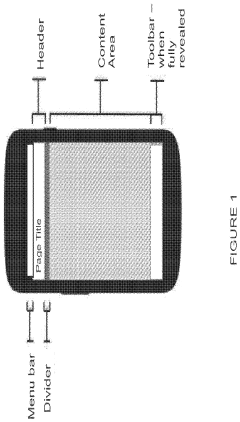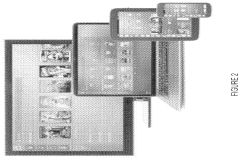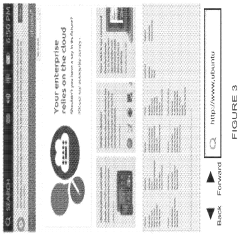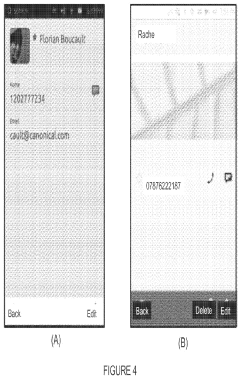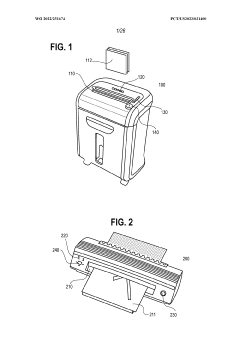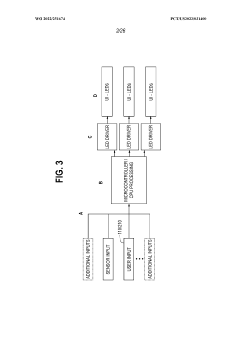How to Align ULED Innovations with Customer Experience?
JUN 20, 20259 MIN READ
Generate Your Research Report Instantly with AI Agent
Patsnap Eureka helps you evaluate technical feasibility & market potential.
ULED Tech Evolution
ULED (Ultra Light Emitting Diode) technology has undergone significant evolution since its inception, driven by the constant pursuit of enhanced customer experience. The journey of ULED innovations can be traced through several key developmental stages, each marking a leap in performance and user satisfaction.
In the early stages, ULED technology focused primarily on improving basic display parameters such as brightness and contrast. Researchers and engineers worked tirelessly to enhance the luminous efficiency of diodes, resulting in displays that could produce brighter images while consuming less power. This initial phase laid the groundwork for future advancements and set the stage for more sophisticated innovations.
As the technology matured, attention shifted towards color reproduction and accuracy. ULED displays began incorporating wider color gamuts, allowing for more vibrant and lifelike images. This phase saw the introduction of quantum dot technology, which significantly expanded the range of colors that could be displayed, bringing content to life in ways previously unseen in consumer electronics.
The next evolutionary step focused on refining motion handling and reducing blur. Advanced algorithms and higher refresh rates were implemented to create smoother on-screen movement, particularly beneficial for fast-paced content such as sports and action movies. This development greatly enhanced the viewing experience, making it more immersive and reducing eye strain during prolonged use.
Recent years have witnessed a push towards improving HDR (High Dynamic Range) capabilities in ULED displays. By increasing the contrast ratio and peak brightness, manufacturers have been able to deliver more realistic and impactful visuals. This has resulted in deeper blacks, brighter whites, and more nuanced details in both shadowy and bright areas of the screen.
The latest frontier in ULED evolution involves the integration of AI and machine learning algorithms. These technologies are being employed to dynamically adjust picture settings based on ambient lighting conditions and content type. This adaptive approach ensures that viewers always experience optimal picture quality, regardless of their viewing environment or the nature of the content being displayed.
Throughout this evolutionary process, a consistent focus has been maintained on aligning technological advancements with customer needs and preferences. User feedback and market research have played crucial roles in guiding the direction of ULED innovations, ensuring that each new development contributes meaningfully to the overall viewing experience.
In the early stages, ULED technology focused primarily on improving basic display parameters such as brightness and contrast. Researchers and engineers worked tirelessly to enhance the luminous efficiency of diodes, resulting in displays that could produce brighter images while consuming less power. This initial phase laid the groundwork for future advancements and set the stage for more sophisticated innovations.
As the technology matured, attention shifted towards color reproduction and accuracy. ULED displays began incorporating wider color gamuts, allowing for more vibrant and lifelike images. This phase saw the introduction of quantum dot technology, which significantly expanded the range of colors that could be displayed, bringing content to life in ways previously unseen in consumer electronics.
The next evolutionary step focused on refining motion handling and reducing blur. Advanced algorithms and higher refresh rates were implemented to create smoother on-screen movement, particularly beneficial for fast-paced content such as sports and action movies. This development greatly enhanced the viewing experience, making it more immersive and reducing eye strain during prolonged use.
Recent years have witnessed a push towards improving HDR (High Dynamic Range) capabilities in ULED displays. By increasing the contrast ratio and peak brightness, manufacturers have been able to deliver more realistic and impactful visuals. This has resulted in deeper blacks, brighter whites, and more nuanced details in both shadowy and bright areas of the screen.
The latest frontier in ULED evolution involves the integration of AI and machine learning algorithms. These technologies are being employed to dynamically adjust picture settings based on ambient lighting conditions and content type. This adaptive approach ensures that viewers always experience optimal picture quality, regardless of their viewing environment or the nature of the content being displayed.
Throughout this evolutionary process, a consistent focus has been maintained on aligning technological advancements with customer needs and preferences. User feedback and market research have played crucial roles in guiding the direction of ULED innovations, ensuring that each new development contributes meaningfully to the overall viewing experience.
CX-Driven Market Demand
The market demand for ULED (Ultra Light Emitting Diode) technology is increasingly driven by customer experience (CX) considerations. As consumers become more discerning, they seek display solutions that offer superior visual quality, energy efficiency, and versatility across various applications.
In the consumer electronics sector, there is a growing appetite for ULED displays in high-end televisions, smartphones, and tablets. Customers are demanding vibrant colors, deeper blacks, and higher contrast ratios, which ULED technology can deliver. The ability of ULED to provide HDR (High Dynamic Range) content with enhanced brightness and color accuracy is particularly appealing to consumers who prioritize immersive viewing experiences.
The automotive industry is another key market where ULED innovations are aligning with customer expectations. As vehicles become more technologically advanced, there is an increasing demand for sophisticated in-car displays that offer clear visibility in various lighting conditions. ULED technology's ability to provide high brightness and contrast makes it ideal for head-up displays (HUDs) and infotainment systems, enhancing both safety and user experience.
In the commercial and retail sectors, ULED displays are gaining traction for digital signage applications. Businesses are recognizing the value of high-quality, eye-catching displays that can effectively engage customers and convey brand messages. The energy efficiency of ULED technology also appeals to companies looking to reduce their operational costs and carbon footprint.
The healthcare industry is showing interest in ULED technology for medical imaging displays. The superior color accuracy and contrast offered by ULED can potentially improve diagnostic accuracy in radiology and other medical imaging applications, directly impacting patient care and outcomes.
As smart home technology becomes more prevalent, there is a growing market for ULED displays in home automation systems. Consumers are looking for intuitive, visually appealing interfaces for controlling various aspects of their home environment, from lighting and security to entertainment systems.
The gaming industry is another sector where ULED innovations are meeting customer demands. Gamers are constantly seeking displays with faster refresh rates, lower latency, and better color reproduction to enhance their gaming experience. ULED technology's ability to deliver on these fronts makes it an attractive option for gaming monitors and consoles.
To fully capitalize on these market opportunities, ULED innovations must continue to focus on enhancing key aspects of customer experience. This includes improving color gamut, increasing energy efficiency, reducing blue light emission for better eye comfort, and developing flexible form factors for diverse applications. Additionally, integrating ULED technology with other emerging technologies like AI and IoT can create more personalized and responsive display solutions, further aligning with evolving customer expectations.
In the consumer electronics sector, there is a growing appetite for ULED displays in high-end televisions, smartphones, and tablets. Customers are demanding vibrant colors, deeper blacks, and higher contrast ratios, which ULED technology can deliver. The ability of ULED to provide HDR (High Dynamic Range) content with enhanced brightness and color accuracy is particularly appealing to consumers who prioritize immersive viewing experiences.
The automotive industry is another key market where ULED innovations are aligning with customer expectations. As vehicles become more technologically advanced, there is an increasing demand for sophisticated in-car displays that offer clear visibility in various lighting conditions. ULED technology's ability to provide high brightness and contrast makes it ideal for head-up displays (HUDs) and infotainment systems, enhancing both safety and user experience.
In the commercial and retail sectors, ULED displays are gaining traction for digital signage applications. Businesses are recognizing the value of high-quality, eye-catching displays that can effectively engage customers and convey brand messages. The energy efficiency of ULED technology also appeals to companies looking to reduce their operational costs and carbon footprint.
The healthcare industry is showing interest in ULED technology for medical imaging displays. The superior color accuracy and contrast offered by ULED can potentially improve diagnostic accuracy in radiology and other medical imaging applications, directly impacting patient care and outcomes.
As smart home technology becomes more prevalent, there is a growing market for ULED displays in home automation systems. Consumers are looking for intuitive, visually appealing interfaces for controlling various aspects of their home environment, from lighting and security to entertainment systems.
The gaming industry is another sector where ULED innovations are meeting customer demands. Gamers are constantly seeking displays with faster refresh rates, lower latency, and better color reproduction to enhance their gaming experience. ULED technology's ability to deliver on these fronts makes it an attractive option for gaming monitors and consoles.
To fully capitalize on these market opportunities, ULED innovations must continue to focus on enhancing key aspects of customer experience. This includes improving color gamut, increasing energy efficiency, reducing blue light emission for better eye comfort, and developing flexible form factors for diverse applications. Additionally, integrating ULED technology with other emerging technologies like AI and IoT can create more personalized and responsive display solutions, further aligning with evolving customer expectations.
ULED Challenges
ULED (Ultra Light Emitting Diode) technology has made significant strides in recent years, offering unprecedented display quality and energy efficiency. However, aligning these innovations with customer experience presents several challenges that need to be addressed.
One of the primary challenges is the high cost associated with ULED technology. While the superior picture quality and energy efficiency are attractive to consumers, the premium price point can be a significant barrier to widespread adoption. Manufacturers must find ways to reduce production costs without compromising on quality to make ULED displays more accessible to a broader market.
Another challenge lies in educating consumers about the benefits of ULED technology. Many customers may not fully understand the advantages of ULED over traditional LED or OLED displays. This lack of awareness can lead to hesitation in investing in ULED products, even when they offer superior performance.
The complexity of ULED technology also poses challenges in terms of user experience. Advanced features and settings may overwhelm some users, potentially leading to frustration or underutilization of the technology's capabilities. Striking a balance between offering cutting-edge features and maintaining user-friendly interfaces is crucial for customer satisfaction.
Durability and longevity concerns also present challenges in aligning ULED innovations with customer expectations. As a relatively new technology, long-term performance data is limited. Consumers may be hesitant to invest in ULED displays without assurances of their lifespan and resistance to issues like burn-in or color degradation over time.
Integration with existing systems and content is another hurdle. While ULED technology offers superior display capabilities, not all content is optimized for this level of quality. This discrepancy can lead to inconsistent viewing experiences, potentially diminishing the perceived value of ULED displays in real-world usage scenarios.
Power consumption, although improved compared to older technologies, remains a concern for some consumers. Balancing the desire for larger, brighter displays with energy efficiency goals can be challenging, especially as environmental consciousness grows among consumers.
Finally, the rapid pace of technological advancement in the display industry poses a challenge for ULED adoption. Consumers may be hesitant to invest in ULED technology if they perceive that it might soon be superseded by newer innovations. Manufacturers must navigate this by clearly communicating the long-term value and upgradability of ULED products.
One of the primary challenges is the high cost associated with ULED technology. While the superior picture quality and energy efficiency are attractive to consumers, the premium price point can be a significant barrier to widespread adoption. Manufacturers must find ways to reduce production costs without compromising on quality to make ULED displays more accessible to a broader market.
Another challenge lies in educating consumers about the benefits of ULED technology. Many customers may not fully understand the advantages of ULED over traditional LED or OLED displays. This lack of awareness can lead to hesitation in investing in ULED products, even when they offer superior performance.
The complexity of ULED technology also poses challenges in terms of user experience. Advanced features and settings may overwhelm some users, potentially leading to frustration or underutilization of the technology's capabilities. Striking a balance between offering cutting-edge features and maintaining user-friendly interfaces is crucial for customer satisfaction.
Durability and longevity concerns also present challenges in aligning ULED innovations with customer expectations. As a relatively new technology, long-term performance data is limited. Consumers may be hesitant to invest in ULED displays without assurances of their lifespan and resistance to issues like burn-in or color degradation over time.
Integration with existing systems and content is another hurdle. While ULED technology offers superior display capabilities, not all content is optimized for this level of quality. This discrepancy can lead to inconsistent viewing experiences, potentially diminishing the perceived value of ULED displays in real-world usage scenarios.
Power consumption, although improved compared to older technologies, remains a concern for some consumers. Balancing the desire for larger, brighter displays with energy efficiency goals can be challenging, especially as environmental consciousness grows among consumers.
Finally, the rapid pace of technological advancement in the display industry poses a challenge for ULED adoption. Consumers may be hesitant to invest in ULED technology if they perceive that it might soon be superseded by newer innovations. Manufacturers must navigate this by clearly communicating the long-term value and upgradability of ULED products.
CX-Aligned Solutions
01 ULED display technology advancements
Ultra Light Emitting Diode (ULED) technology has seen significant advancements in display quality, brightness, and energy efficiency. These improvements enhance the overall customer experience by providing superior image quality, deeper blacks, and more vibrant colors compared to traditional LED displays.- ULED display technology advancements: Ultra Light Emitting Diode (ULED) technology has seen significant advancements in display quality, brightness, and energy efficiency. These improvements enhance the overall customer experience by providing superior image quality, deeper blacks, and more vibrant colors compared to traditional LED displays. The technology also allows for thinner and lighter display panels, making it suitable for various applications.
- ULED lighting solutions for improved user comfort: ULED lighting solutions are being developed to enhance user comfort in various environments. These solutions incorporate advanced control systems, adjustable color temperatures, and dimming capabilities to create customizable lighting experiences. The technology aims to reduce eye strain, improve mood, and increase productivity in both residential and commercial settings.
- Integration of ULED technology in automotive applications: ULED technology is being integrated into automotive applications to enhance the driving experience. This includes advanced headlight systems, interior ambient lighting, and display panels for infotainment systems. The use of ULED in vehicles offers improved visibility, energy efficiency, and customizable lighting options for drivers and passengers.
- ULED-based smart home and IoT devices: ULED technology is being incorporated into smart home and Internet of Things (IoT) devices to improve user interaction and functionality. This includes smart lighting systems, display panels for home automation controls, and energy-efficient indicators for various appliances. The integration of ULED in these devices offers enhanced visual feedback and improved energy management for a better overall user experience.
- ULED manufacturing processes for improved product quality: Advancements in ULED manufacturing processes are focusing on improving product quality and consistency. These developments include new materials, fabrication techniques, and quality control measures to enhance the performance and longevity of ULED devices. The improved manufacturing processes result in more reliable and higher-quality products, ultimately leading to better customer satisfaction and experiences.
02 ULED lighting solutions for improved user comfort
ULED lighting solutions are being developed to enhance user comfort in various environments. These solutions focus on reducing eye strain, providing customizable color temperatures, and offering seamless dimming capabilities, resulting in a more pleasant and adaptable lighting experience for customers.Expand Specific Solutions03 Integration of ULED technology in smart home systems
ULED technology is being integrated into smart home systems, allowing for enhanced control and customization of lighting and display elements. This integration enables users to create personalized environments, automate lighting schedules, and sync ULED devices with other smart home components for a more cohesive and convenient user experience.Expand Specific Solutions04 ULED applications in automotive lighting and displays
ULED technology is being applied to automotive lighting and displays, improving both functionality and aesthetics. These applications include advanced headlights, interior ambient lighting, and high-resolution dashboard displays, enhancing the overall driving experience and vehicle safety.Expand Specific Solutions05 Energy-efficient ULED solutions for extended battery life
Researchers are developing energy-efficient ULED solutions that significantly extend battery life in portable devices. These advancements allow for longer usage times between charges, brighter displays, and improved overall performance in smartphones, tablets, and other mobile devices, enhancing the customer experience through increased convenience and reliability.Expand Specific Solutions
Key ULED Players
The ULED (Ultra Light Emitting Diode) market is in a growth phase, with increasing demand for enhanced customer experiences driving innovation. Major players like Samsung Electronics, LG Electronics, and Sony are investing heavily in ULED technology, focusing on improving display quality and energy efficiency. The market size is expanding rapidly, with applications ranging from consumer electronics to automotive displays. Technological maturity varies among companies, with industry leaders like Apple and Qualcomm pushing boundaries in miniaturization and integration. Emerging players such as eLux and Lumileds are introducing novel approaches to ULED design, while established firms like Siemens and Dell are exploring applications in diverse sectors, indicating a competitive and dynamic landscape.
Samsung Electronics Co., Ltd.
Technical Solution: Samsung has developed a revolutionary ULED (Ultra LED) technology that combines quantum dot color conversion with micro-LED backlighting. This innovation allows for precise control of local dimming zones, resulting in superior contrast ratios and deeper blacks. Samsung's ULED displays also incorporate AI-powered image processing algorithms that optimize picture quality in real-time based on content and ambient lighting conditions. To enhance customer experience, Samsung has integrated voice control and gesture recognition features, allowing users to interact with their ULED displays more intuitively.
Strengths: Superior image quality, energy efficiency, and advanced user interface. Weaknesses: Higher production costs and potential complexity for some users.
Apple, Inc.
Technical Solution: Apple's approach to ULED technology in their displays focuses on integrating their custom-designed chips and software for optimal performance. Their ULED displays utilize mini-LED backlighting with thousands of local dimming zones, combined with advanced color calibration techniques. Apple has also developed a ProMotion technology for their ULED displays, offering variable refresh rates up to 120Hz for smoother motion. To enhance customer experience, Apple has integrated their ecosystem seamlessly with ULED displays, allowing for easy content sharing from other Apple devices and personalized recommendations through machine learning algorithms.
Strengths: Seamless ecosystem integration, high refresh rates, and color accuracy. Weaknesses: Limited availability outside of Apple products and potentially higher costs.
ULED-CX Integration
User interface for a computing device
PatentActiveUS20220150344A1
Innovation
- The Ubuntu user interface employs edge gestures, ranged gestures, a unified welcome screen, and a head-up display (HUD) to provide a consistent and scalable touch experience across devices, allowing for one-handed operation on smartphones, two-handed interaction on tablets, and keyboard usage on PCs, with a remote-controlled TV interface, using a swipe-based navigation system and HUD for search and control access.
User interface which induces machine operator interaction and efficiencies
PatentWO2022251674A1
Innovation
- A unified user interface (UI) using RGB LEDs or OLED screens that provides centralized, expressive feedback through visual, auditory, and haptic means, guiding operators to optimize machine operation by conveying machine status, consumable levels, and task progress, thereby encouraging efficient interaction and reducing errors.
ULED Ecosystem
The ULED (Ultra Light Emitting Diode) ecosystem encompasses a complex network of technologies, manufacturers, suppliers, and end-users that collectively drive the development and adoption of ULED innovations. This ecosystem plays a crucial role in aligning ULED advancements with customer experience, as it facilitates the seamless integration of cutting-edge display technologies into various consumer products.
At the core of the ULED ecosystem are the semiconductor manufacturers who produce the essential components for ULED displays. These companies invest heavily in research and development to create more efficient, brighter, and longer-lasting ULED chips. Their innovations directly impact the quality of the final product and, consequently, the customer experience.
Display panel manufacturers form another vital part of the ecosystem. They integrate ULED chips into larger display panels, optimizing factors such as pixel density, color accuracy, and power efficiency. These manufacturers work closely with both chip producers and device makers to ensure that ULED panels meet the specific requirements of different applications, from smartphones to large-format displays.
Device manufacturers represent the bridge between ULED technology and end-users. They incorporate ULED displays into a wide range of products, including televisions, smartphones, tablets, and automotive displays. These companies play a crucial role in translating ULED innovations into tangible benefits for consumers, such as improved image quality, energy efficiency, and device form factors.
Software developers and content creators are increasingly important players in the ULED ecosystem. They develop applications and content that leverage the unique capabilities of ULED displays, such as high dynamic range (HDR) and wide color gamut. Their efforts ensure that consumers can fully appreciate the visual enhancements offered by ULED technology across various media and applications.
Retail channels and marketing teams also contribute significantly to the ecosystem by educating consumers about the benefits of ULED technology and facilitating the purchase decision process. Their role is crucial in communicating the value proposition of ULED-equipped devices and driving market adoption.
Lastly, industry standards organizations and regulatory bodies play a vital role in the ULED ecosystem by establishing guidelines for performance, interoperability, and safety. These standards ensure consistency across the industry and help build consumer trust in ULED technology.
At the core of the ULED ecosystem are the semiconductor manufacturers who produce the essential components for ULED displays. These companies invest heavily in research and development to create more efficient, brighter, and longer-lasting ULED chips. Their innovations directly impact the quality of the final product and, consequently, the customer experience.
Display panel manufacturers form another vital part of the ecosystem. They integrate ULED chips into larger display panels, optimizing factors such as pixel density, color accuracy, and power efficiency. These manufacturers work closely with both chip producers and device makers to ensure that ULED panels meet the specific requirements of different applications, from smartphones to large-format displays.
Device manufacturers represent the bridge between ULED technology and end-users. They incorporate ULED displays into a wide range of products, including televisions, smartphones, tablets, and automotive displays. These companies play a crucial role in translating ULED innovations into tangible benefits for consumers, such as improved image quality, energy efficiency, and device form factors.
Software developers and content creators are increasingly important players in the ULED ecosystem. They develop applications and content that leverage the unique capabilities of ULED displays, such as high dynamic range (HDR) and wide color gamut. Their efforts ensure that consumers can fully appreciate the visual enhancements offered by ULED technology across various media and applications.
Retail channels and marketing teams also contribute significantly to the ecosystem by educating consumers about the benefits of ULED technology and facilitating the purchase decision process. Their role is crucial in communicating the value proposition of ULED-equipped devices and driving market adoption.
Lastly, industry standards organizations and regulatory bodies play a vital role in the ULED ecosystem by establishing guidelines for performance, interoperability, and safety. These standards ensure consistency across the industry and help build consumer trust in ULED technology.
ULED Sustainability
ULED sustainability is a critical aspect of aligning ULED innovations with customer experience. As consumers become increasingly environmentally conscious, the sustainability of ULED technology plays a significant role in shaping their perception and adoption of these products.
One key area of focus is energy efficiency. ULED displays are known for their low power consumption compared to traditional LED and LCD technologies. Manufacturers are continuously working on improving the energy efficiency of ULED panels, reducing power consumption without compromising on picture quality. This not only aligns with customer expectations for eco-friendly products but also translates to lower electricity bills, enhancing the overall user experience.
Material sustainability is another crucial factor. ULED manufacturers are investing in research and development to create more sustainable materials for their displays. This includes exploring alternatives to rare earth elements and developing recycling processes for ULED components. By reducing the environmental impact of production and end-of-life disposal, companies can appeal to environmentally conscious consumers and meet increasingly stringent regulations.
Longevity and durability are essential aspects of ULED sustainability that directly impact customer experience. ULED displays are designed to have a longer lifespan compared to conventional display technologies. This durability not only reduces electronic waste but also provides customers with a product that maintains its performance over an extended period, justifying the initial investment.
Packaging and shipping practices are also being optimized to reduce the carbon footprint of ULED products. Manufacturers are adopting more compact and recyclable packaging materials, as well as optimizing logistics to minimize transportation emissions. These efforts contribute to the overall sustainability of ULED technology and resonate with customers who value environmentally responsible practices.
Smart features integrated into ULED displays can further enhance sustainability and user experience. For instance, ambient light sensors and automatic brightness adjustment can optimize power consumption based on viewing conditions. Additionally, software updates can improve energy efficiency and extend the functional lifespan of the devices, aligning with customer expectations for long-term value and reduced environmental impact.
By prioritizing sustainability in ULED innovations, manufacturers can create a compelling value proposition that resonates with environmentally conscious consumers. This alignment between technological advancements and sustainability not only enhances customer experience but also positions ULED technology as a responsible choice for the future of display technology.
One key area of focus is energy efficiency. ULED displays are known for their low power consumption compared to traditional LED and LCD technologies. Manufacturers are continuously working on improving the energy efficiency of ULED panels, reducing power consumption without compromising on picture quality. This not only aligns with customer expectations for eco-friendly products but also translates to lower electricity bills, enhancing the overall user experience.
Material sustainability is another crucial factor. ULED manufacturers are investing in research and development to create more sustainable materials for their displays. This includes exploring alternatives to rare earth elements and developing recycling processes for ULED components. By reducing the environmental impact of production and end-of-life disposal, companies can appeal to environmentally conscious consumers and meet increasingly stringent regulations.
Longevity and durability are essential aspects of ULED sustainability that directly impact customer experience. ULED displays are designed to have a longer lifespan compared to conventional display technologies. This durability not only reduces electronic waste but also provides customers with a product that maintains its performance over an extended period, justifying the initial investment.
Packaging and shipping practices are also being optimized to reduce the carbon footprint of ULED products. Manufacturers are adopting more compact and recyclable packaging materials, as well as optimizing logistics to minimize transportation emissions. These efforts contribute to the overall sustainability of ULED technology and resonate with customers who value environmentally responsible practices.
Smart features integrated into ULED displays can further enhance sustainability and user experience. For instance, ambient light sensors and automatic brightness adjustment can optimize power consumption based on viewing conditions. Additionally, software updates can improve energy efficiency and extend the functional lifespan of the devices, aligning with customer expectations for long-term value and reduced environmental impact.
By prioritizing sustainability in ULED innovations, manufacturers can create a compelling value proposition that resonates with environmentally conscious consumers. This alignment between technological advancements and sustainability not only enhances customer experience but also positions ULED technology as a responsible choice for the future of display technology.
Unlock deeper insights with Patsnap Eureka Quick Research — get a full tech report to explore trends and direct your research. Try now!
Generate Your Research Report Instantly with AI Agent
Supercharge your innovation with Patsnap Eureka AI Agent Platform!
